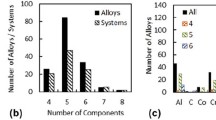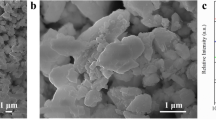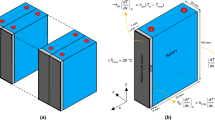Abstract
As a first step in evaluating materials for a concentrated solar power (CSP), supercritical CO2 Brayton cycle, experiments are being conducted to simulate the daily operating cycle using 10-h thermal cycles in 1 bar CO2 at 700–800 °C. After 1000-h exposures, the mass gains for commercial Ni-base alloys 740H, 282, 625 and Fe-base alloy 25 were relatively low with correspondingly thin reaction products. At 800 °C, similar reaction products were obtained for thermal cycling in CO2 and dry air, which also could simulate the outside of the primary heat exchanger. In addition, 500-h cycles were conducted at 750 °C, which showed slightly higher mass gains than the 10-h cycles. In general, there were no indications of internal carburization for these four alloys after 1000 h and the measured rate constants are sufficiently low to meet the 30-year CSP lifetime goal.











Similar content being viewed by others
References
V. Dostal, P. Hejzlar and M. J. Driscoll, Nuclear Technology 154, 2006 (283).
R. Chacartegui, J. M. Muñoz De Escalona, D. Sánchez, B. Monje and T. Sánchez, Applied Thermal Engineering 31, 2011 (5).
V. Cheang, R. Hedderwick, and C. McGregor, Solar Energy, 113, 2015 (199–211).
E. G. Feher, Energy Conversion 8, 1968 (85).
C. Oh, T. Lillo, W. Windes, T. Totemeier, B. Ward, R. Moore, and R. Barner, Idaho National Laboratory Report INL/EXT-06-01271, Idaho Falls, ID, 2006.
B. A. Pint and J. R. Keiser, JOM 67, 2015 (2615–2620).
R. I. Olivares, D. J. Young, P. Marvig and W. Stein, Oxidation of Metals 84, 2015 (585).
B. A. Pint, R. G. Brese, and J. R. Keiser, Materials and Corrosion 68, 2017 (151–158).
H. E. McCoy, Corrosion 21, 1965 (84).
F. Rouillard, G. Moine, M. Tabrant and J. C. Ruiz, Oxidation of Metals 77, 2012 (57).
T. Furukawa, Y. Inagaki and M. Aritomi, Progress in Nuclear Energy 53, 2011 (1050).
V. Firouzdor, K. Sridharan, G. Cao, M. Anderson and T. R. Allen, Corrosion Science 69, 2013 (281).
T. D. Nguyen, J. Q. Zhang and D. J. Young, Materials at High Temperatures 32, 2015 (16).
B. A. Pint, Material Science Forum 696, 2011 (57).
B. A. Pint, B. N. Anderson, W. J. Matthews, C. Waldhelm, and W. Treece, ASME Paper #GT2013-94939, presented at the International Gas Turbine & Aeroengine Congress & Exhibition, San Antonio, TX, June, 3–7, 2013.
B. A. Pint, P. F. Tortorelli and I. G. Wright, Oxidation of Metals 58, 2002 (73).
E. Essuman, L. R. Walker, P. J. Maziasz and B. A. Pint, Materials Science and Technology 29, 2013 (822–827).
B. Pieraggi, Oxidation of Metals 27, 1987 (177).
H. J. Lee, H. Kim, S. H. Kim and C. Jang, Corrosion Science 99, 2015 (227–239).
J. P. Shingledecker and G. M. Pharr, Journal of Materials Engineering Performance 22, 2013 (454–462).
L. M. Pike, Superalloys 2008, eds. R. C. Reed et al. (TMS, Warrendale, 2008), pp. 191–200.
Acknowledgements
The experimental work at ORNL was conducted by G. Garner, M. Stephens, T. Lowe and T. Jordan. P. F. Tortorelli provided useful comments on the manuscript. The authors appreciate the contributions of our research team members: Brayton Energy, LLC, Special Metals, Haynes International and Sandvik and the input of others from the CSP/sCO2 industry. This research was funded by the SunShot Initiative under the US Department of Energy’s Office of Energy Efficiency and Renewable Energy, Solar Energy Technology Program: SuNLaMP Award Number DE-EE0001556.
Author information
Authors and Affiliations
Corresponding authors
Additional information
This manuscript has been authored by UT-Battelle, LLC under Contract No. DE-AC05-00OR22725 with the U.S. Department of Energy. The United States Government retains and the publisher, by accepting the article for publication, acknowledges that the United States Government retains a non-exclusive, paid-up, irrevocable, world-wide license to publish or reproduce the published form of this manuscript, or allow others to do so, for United States Government purposes. The Department of Energy will provide public access to these results of federally sponsored research in accordance with the DOE Public Access Plan (http://energy.gov/downloads/doe-public-access-plan).
Rights and permissions
About this article
Cite this article
Brese, R.G., Keiser, J.R. & Pint, B.A. Effect of Thermal Cycling on Compatibility in CO2 for Concentrated Solar Power Applications. Oxid Met 87, 631–642 (2017). https://doi.org/10.1007/s11085-017-9762-0
Received:
Published:
Issue Date:
DOI: https://doi.org/10.1007/s11085-017-9762-0




